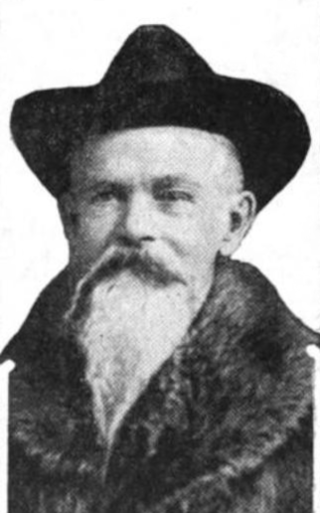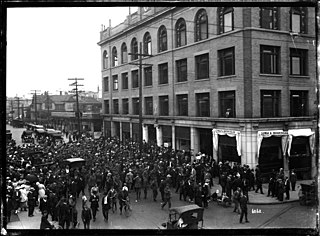
The Knights of Labor, officially the Noble and Holy Order of the Knights of Labor, was an American labor federation that was active in the late 19th century, especially the 1880s. It operated in the United States as well in Canada, and had chapters also in Great Britain and Australia. Its most important leader was Terence V. Powderly. The Knights of Labor promoted the social and cultural uplift of the worker, and demanded the eight-hour day. In some cases it acted as a labor union, negotiating with employers, but it was never well organized or funded. It was notable in its ambition to organize across lines of gender and race and in the inclusion of both skilled and unskilled labor. After a rapid expansion in the mid-1880s, it suddenly lost its new members and became a small operation again. The Knights of Labor had served, however, as the first mass organization of the white working class of the United States.

The Winnipeg General Strike of 1919 was one of the most famous and influential strikes in Canadian history. For six weeks, May 15 to June 26, more than 30,000 strikers brought economic activity to a standstill in Winnipeg, Manitoba, which at the time was Canada's third largest city. In the short term, the strike ended in arrests, bloodshed and defeat, but in the long run it contributed to the development of a stronger labour movement and the tradition of social democratic politics in Canada.

The Communications Workers of America (CWA) is the largest communications and media labor union in the United States, representing about 700,000 members in both the private and public sectors. The union has 27 locals in Canada via CWA-SCA Canada representing about 8,000 members. CWA has several affiliated subsidiary labor unions bringing total membership to over 700,000. CWA is headquartered in Washington, DC, and affiliated with the AFL–CIO, the Strategic Organizing Center, the Canadian Labour Congress, and UNI Global Union.

James "Jimmie" Simpson was a British-Canadian trade unionist, printer, journalist and left-wing politician in Toronto, Ontario. He was a longtime member of Toronto's city council and served as Mayor of Toronto in 1935, the first member of the Cooperative Commonwealth Federation to serve in that capacity. He was also a member of the Orange Order in Canada.

Communications, Energy and Paperworkers Union of Canada, abbreviated CEP in English and SCEP in French, was a largely private-sector labour union with 150,000 members, active from 1992 to 2013. It was created in 1992 through the merger of three unions: the Canadian Paperworkers Union, the Communications and Electrical Workers of Canada, and the Energy and Chemical Workers Union. See below for some other unions that were merged into the CEP. CEP/SCEP was affiliated to the Canadian Labour Congress.

Abram William Lauder was a Canadian lawyer and political figure. He represented Grey South in the Legislative Assembly of Ontario from 1867 to 1874 and Grey East from 1875 to 1884.
The International Typographical Union (ITU) was a North American trade union for the printing trade for newspapers and other media. It was founded on May 3, 1852, in the United States as the National Typographical Union, and changed its name to the International Typographical Union at its Albany, New York, convention in 1869 after it began organizing members in Canada. The ITU was one of the first unions to admit female members, admitting women members such as Augusta Lewis, Mary Moore and Eva Howard in 1869.

Daniel John O'Donoghue was a printer, labour leader and political figure in Ontario. O'Donoghue is recognized as one of the original founders of organized labour in Canada and in 1874 he became the first labour candidate election to a Canadian legislature.

The Globe was a Canadian newspaper in Toronto, Ontario, founded in 1844 by George Brown as a Reform voice. It merged with The Mail and Empire in 1936 to form The Globe and Mail.
Ottawa Trades Council was the first local labour central body established to unite workers in the city of Ottawa, Canada.

The Vancouver general strike which took place on 2 August 1918, was the first general strike in Canadian history. There had been talks of organizing a general strike for quite some time due to federal conscription, censorship of socialist publications, and workers' demands for higher wages. War-time inflation reduced real income profoundly and throughout the First World War Vancouver shipbuilders experienced a labour shortage. Numerous government policies had suppressed the work of labour activists such as strikes, lockouts and certain presses being banned. Workers were also inspired by factors such as the Bolshevik Revolution the previous year and the rising cost of living. The strike was eventually organized as a one-day political protest after the killing of draft evader and labour activist Albert "Ginger" Goodwin on 27 July. He had previously called for a general strike in case any worker was drafted against their will.

The New Orleans general strike was a general strike in the U.S. city of New Orleans, Louisiana, United States, that began on November 8, 1892. Despite appeals to racial hatred, black and white workers remained united. The general strike ended on November 12, with unions gaining most of their original demands.
This is a timeline of labour issues and events in Canada.
Gregory S. Kealey is a historian of the working class in Canada, founding editor of the journal Labour/Le Travail, and former vice-president (research) and provost of the University of New Brunswick, where he is Professor Emeritus of History. The author and editor of numerous books and articles on labour history, intelligence studies, and state security, Kealey is a fellow of the Royal Historical Society and Royal Society of Canada and served as president of the Canadian Historical Association. In 2016 the Canadian Historical Review published a memoir of his career. In 2017 he was appointed a member of the Order of Canada.
The Printing Industry Employees' Union of Australia (PIEUA) was an Australian trade union which existed between 1915 and 1966. It represented a range of production and trades workers in the printing industry.

The Toronto Labour Day Parade is an annual event held in the city of Toronto. The parade is organized by the Toronto and York District Labour Council following a route down University Avenue, then west along Queen Street West then proceeding down Dufferin Street entering the Canadian National Exhibition via the Dufferin Gate.

The Printing and Kindred Trades Federation (P&KTF) was a trade union federation in the United Kingdom.

Robert Harper Babcock was an American historian of North American labor.

The Canadian Labour Revolt was a loosely connected series of strikes, riots, and labour conflicts that took place across Canada between 1918 and 1925, largely organized by the One Big Union (OBU).
The South African Typographical Union (SATU) is a trade union representing workers in the printing and media industries in South Africa.













